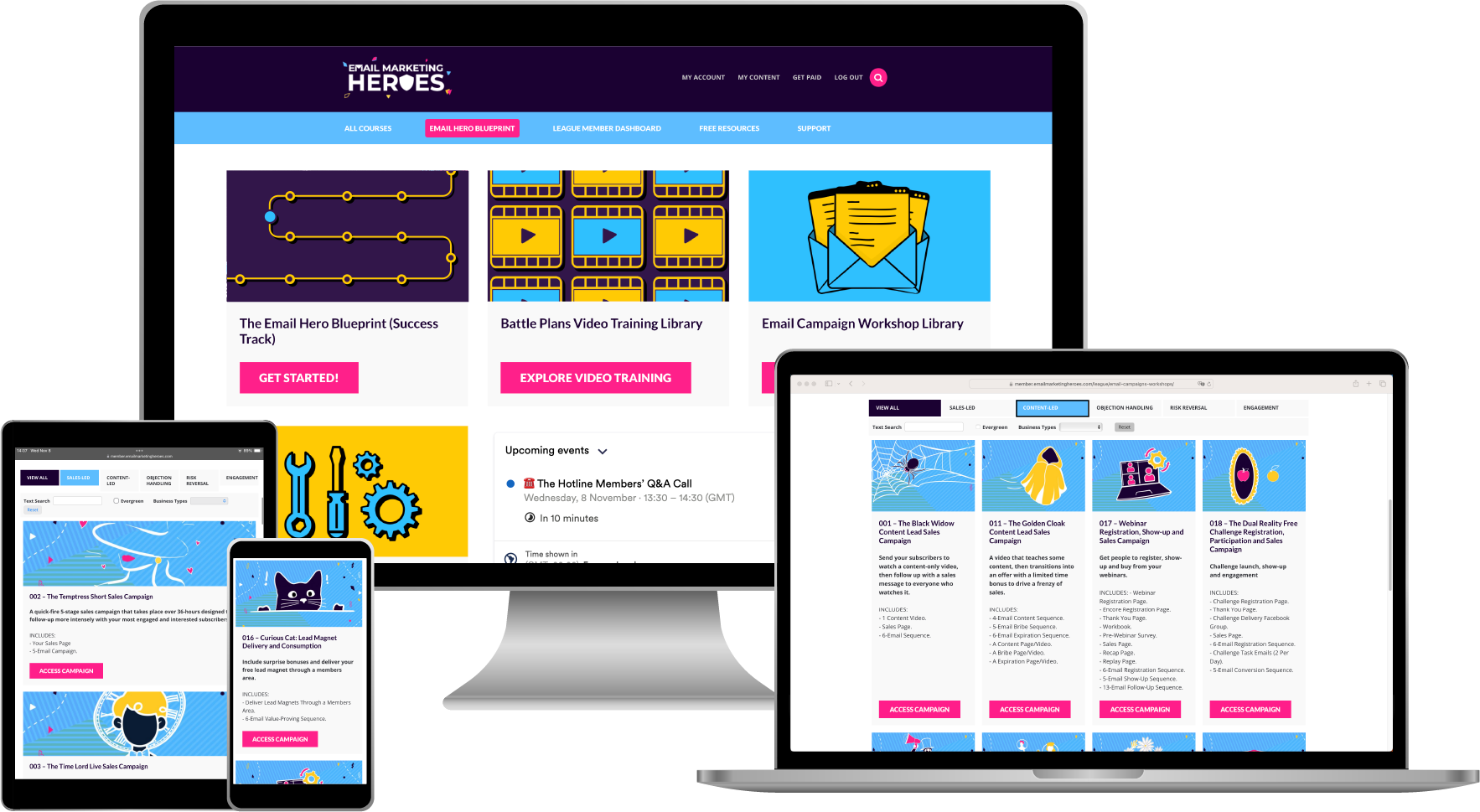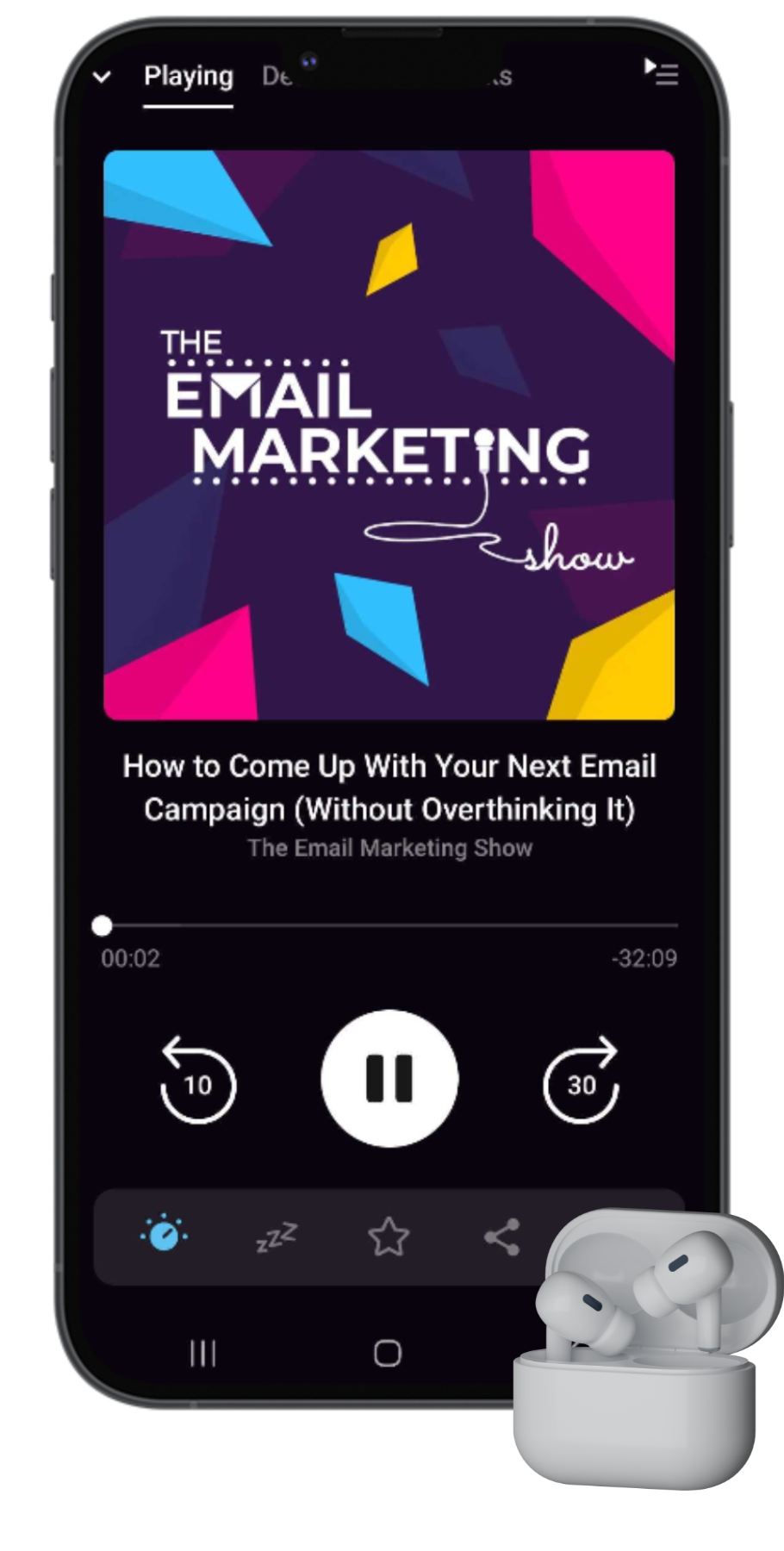
How to create and sell courses online that people actually want
There's nothing worse than spending time and energy into creating an online course and then finding out that nobody actually wants to buy it, right? We've been there and done that. So here are our best tips to help you create and sell courses online. The trick? You want to be sure that people in your audience will actually go out of their way to pay you money for the course you put together.
Ready to find out how to do this thing?
SOME EPISODE HIGHLIGHTS: (5:06) Why you need to create a course about something you're passionate about. (7:44) Why you need to have an audience before you start selling a course. (9:55) Why you need to pay attention to the questions your audience asks you. (11:48) The difference between "problem aware" courses and "solution aware" courses. (15:15) Why you should always tell your audience about the price of your online course. (18:02) Why you need to get people involved into the creation of your course. (19:48) Why you need to ask questions and run surveys. (23:57) Why you're NOT your target market. (26:12) Why the value isn't in the quantity. (28:36) Subject line of the week.

The Top 10 Books To 'Power Up' Your Email Marketing
10 book recommendations that will improve all areas of your email marketing (including some underground treasures that we stumbled upon which have been game-changing for us).
Why you need to create a course about something you're passionate about (but also think about profitability!)
So you've created this online course and put it on the internet. You think everyone in your audience has seen it because of course people see 100% of our content online, don't they? (Or do they?!)
But no one bought it.
Why? Well, maybe you've created a course that nobody wants. Or maybe you just don't know how to get people interested in buying it. And you know what? We don't want this for you. We want you to be able to create and sell courses online like a pro.
So how exactly are you going to do that?
We all love sharing stuff we're passionate about, don't we? That's why we get excited about the stuff we teach. But just because we're passionate about the topic of a course we created, it doesn't mean we're going to easily sell that thing. The process of creating the course takes a lot of time and effort. But the key is to construct an offer and a sales process that will make people buy your course.
Your passion will help you through all the hard work you need to do to bring your course into the world. But make sure you also strike the right balance between what you're passionate about and what's profitable.
Why you need to have an audience before you create and sell courses online
It's really hard to create a course and sell it at scale if you don't already have some people who might be interested in buying it. Ideally, you want some kind of audience already in place that will pay attention to what you sell. So build an audience first. You can start on social media, but make sure you then move them onto your email list.
And if you're worried about not having a product to sell to your list just yet, you can be an affiliate for someone else. Or you can simply point your subscribers to your flagship content. This could be your podcast, your blog posts, your YouTube channel, or the content in your Facebook group – whatever it might be. But first things first, build a list of people who are your perfect customers.
Why you need to pay attention to the questions your audience asks you
Once you've got an audience, you need to pay attention to the questions they ask you. Because those will give you insight into the minds of your customers and fuel the content of your online course.
And that's much better (in our opinion) than focusing on customer avatars! Because it's less about the car your people drive, the newspaper they read, or the cereal they eat in the morning, than it is about their mindset. What matters is where your customers are at. Are they ready to buy this thing you're selling?
So pay attention to the trends amongst the people who become your best customers. Those are the ones who buy your products and give you the least hassle. Focus on their mindset and the belief they hold. And then start crafting your courses to serve those particular kinds of markets.
Create and sell courses online for people who are “problem aware” vs “solution aware”
Another decision you need to make when you want to create and sell courses online is whether your course will address the problem that your ideal clients have or the solution that you offer. Some of your customers will be more “problem aware” while others will be “solution aware”.
Here's the difference with an example. Some of the members in our membership, The League, want to sell more courses online, for example. That's a problem they have – they have a thing they want to sell and want to find a way to sell more of it. These people are “problem aware”.
But we also help people who have figured out that the best way to sell more of their stuff is through email marketing. These members are “solution aware”.
In the same way, you'll have people in your audience who are “problem aware” and others who are “solution aware”. And you'll want to create different types of courses for them, which you'll also market differently.
This is why we don't believe in customer avatars. Because knowing how to address the people in your audience who are “problem aware” vs the ones who are “solution aware” is much more important than what age bracket or demographic they're in. So instead of focusing on customer avatars, focus on the mindset of your ideal clients.
Why you should tell your audience about the price of our course
Another thing we suggest you do when you start to create and sell courses online is to reach out to your audience – either via social media or email – and tell them you're putting together a course. You also want to tell them the price of the course and ask if they want the link to it. Here's your formula: “I'm putting together a course about this thing. It's going to be this price. Who would like the link?”
Telling your audience about the price is important because you want anyone who responds to your post or email to know there's a price for whatever you're offering – it's not free! And you don't want to attract people who are mildly or passively interested in your course. You want to attract people who will go out of their way to pay for the information you're offering.
At this point, you haven't created the course yet. And if you don't get any replies (or not enough to make it worth your while), then guess what? You've just discovered there isn't enough interest in that course. But at least you haven't wasted any time, effort, and energy in creating something that wouldn't have sold well for you.
Why you need to get people excited about your course
So you told your audience about your course, you told them how much it's going to be, and you sent out the link to it. Now it's time to create some involvement and excitement by getting people to express their choices and “vote” on things like the name, the cover, the graphic, etc. Why? Because you want to make people emotionally involved in the process. This gives them a buy-in into the creation and the genesis of the whole course, and it's going to work wonders for you.
We did the same to come up with a name for our membership, The League. We opened it up to our audience and asked for ideas. And yes, it meant we handed over some creative control, but we also got some fantastic suggestions and made our audience feel involved in the process from the very beginning.
Why you need to ask questions and run surveys
We are big believers in running surveys. Because they help you find out what your audience's biggest and most frustrating problems are, what their objections are, and what they're trying to overcome. Asking people about them and their experiences is another thing that makes them emotionally buy into the process of discovery and creation of the course.
Plus, when you pay attention to the things your audience says and the language they use, you'll know what content to create for your course.
You know when you're walking down the street, and you hear someone shout your name? It might not be you they're after, but you automatically pay attention. This is the same thing. When your ideal clients hear you using the exact words and phrases they use to talk about their problems, their subconscious brain sits up and pays attention. And when you speak your customers' language, you're able to create a course with a name, a hook, and an offer that will make your audience sit up and pay attention.
Why you need to check what ads people are running
Another strategy that might come in handy before you go ahead and create your course is to check what adverts other people are already running on Facebook. You can see the Facebook Ads Library here as part of Facebook's transparency policy.
Doing this bit of research gives you an idea of who's running which ads and what kind of things are popular. So think of competitors or someone who's in your space and look at what ads they're running. Pay particular attention to what wording they're using to make sure there's an opportunity and an audience out there for the course you're about to create.
Why you're not your target market
One of the things we've been guilty of in the past is to fall into the trap of thinking that we are our own target market. But we're not. Even if you used to be in the position of the people you're now selling to, you are not anymore. You are not your target market.
The minute you become the course creator, you're no longer in the same place you were before. We say this a lot – you are not typical. So when thinking about the topic or content of your course don't pay too much attention to what you want or what you used to want because the world changes fast, and you're just not you're target market anymore.
Why the value isn't in the quantity
And last but not least, another thing to bear in mind when you create and sell courses online is that the value of your course isn't in the length or quantity of your content. Because people want to get rid of their ‘pain' – of their problem – as quickly as possible and with the least amount of effort. And they'll actually pay more for that privilege because we're all busy and happy to pay a premium to solve our problems in less time. Here's something worth remembering – the quantity of something isn't the value. The transformation is the value.
Subject line of the week
This week's subject line of the week is, “Invite! (Short notice)” and it's something we sent out to tell our subscribers about a last-minute webinar we were running. You see, normally, we'd start promoting a webinar 3 to 5 days in advance. But in this case, it was super short notice. So we wanted to get as many people as possible onto it.
So with this subject line, we used the word “invite”. We do a variation of this every time we run an event and might use words like “invitation” or “RSVP” in the subject line. But what this subject line also did very well was creating some sort of urgency. A lot of good subject lines are about generating curiosity, but the words “short notice” triggered urgency too. And while the amount of people who signed up for this webinar isn't the most we've ever had, the rate of registrants to attendees was the highest. This means that the majority of people who registered actually attended. And that's great!
Useful Episode Resources
Related episodes
Bottomless Email Content To Promote Your Courses And Programs.
How To Sell Without Price Cutting or Pushing with Mike Montague from Sandler Training.
FREE list of the top 10 books to improve your email marketing
If you want to write better emails, come up with better content, and move your readers to click and buy, here's how. We put together this list of our Top 10 most highly recommended books that will improve all areas of your email marketing (including some underground treasures that we happened upon, which have been game-changing for us). Grab your FREE list here.
Join our FREE Facebook group
If you want to chat about how you can maximise the value of your email list and make more money from every subscriber, we can help! We know your business is different, so come and hang out in our FREE Facebook group, the Email Marketing Show Community for Course Creators and Coaches. We share a lot of training and resources, and you can talk about what you're up to.
Try ResponseSuite for $1
This week's episode is sponsored by ResponseSuite.com, the survey quiz and application form tool that we created specifically for small businesses like you to integrate with your marketing systems to segment your subscribers and make more sales. Try it out for 14 days for just $1.
Join The League Membership
Not sick of us yet? Every day we hang out in our amazing community of Email Marketing Heroes. We share all of our training and campaigns and a whole bunch of other stuff. If you're looking to learn how to use psychology-driven marketing to level up your email campaigns, come and check out The League Membership. It's the number one place to hang out and grow your email marketing. Best news yet? You can apply everything we talk about in this show.
Subscribe and review The Email Marketing Show podcast
Thanks so much for tuning into the podcast! If you enjoyed this episode (all about how to create and sell courses online) and love the show, we'd really appreciate you subscribing and leaving us a review of the show on your favourite podcast player.
Not only does it let us know you're out there listening, but your feedback helps us to keep creating the most useful episodes so more awesome people like you can discover the podcast.






